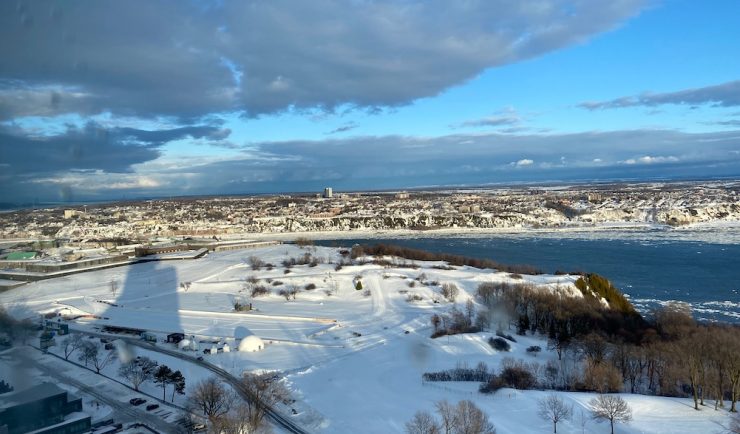 Road Trip Day 1 (Tuesday)
Road Trip Day 1 (Tuesday)
It all started at home, grinding out quality training hours in spectacularly good ski conditions. The plan was simple: A skiing road trip with three World Cup events, followed by Nationals/SuperTour finals at home, culminating in a 50km against the best skiers in North America. Start Wednesday March 11th, arrive home on the 24th, and closing out the racing season on April 2nd.

With restricted training opportunities during the trip, it was important to log quality hours before heading out for what would be a two week ‘masters taper’.
The first stage of the trip was driving to Canmore. With the Monashee, Selkirk, and Rocky mountain ranges separating home from Canmore, it is always good to have flexibility to travel between storms. With a snowfall warning and 25cm expected late Tuesday through Wednesday, we decided to drive early Tuesday. The plan worked. We were ahead of the storm by Revelstoke (two hours into the trip) and had bare and dry roads for the majority of the drive. We arrived in Canmore before noon, local time, and we set out for a ski.
Canmore is an unusual ski area in that it is located in a precipitation shadow and relies almost entirely on snowmaking. Before the 2016 Ski Tour Canada, locals told us that it hadn’t snowed since December. It was easy to find the race course a week out from that event: A thin line of snow snaked around the course and the 4km night loop. As we only make the drive for events like World Cups and nationals, we had never seen Canmore fully open.
Seeing every trail open was a shock, but a good one. Everyone had said the skiing was great this year, but the same people describe Frozen Thunder as great. 2016 was a pretty good visit, but as it was the end of the Tour de Food Poisoning, we didn’t fully appreciate having a few rec trails open. (Food Poisoning? Our delayed arrival in Gatineau for STC 2016 resulted in us sharing dinner with the Swedish team. We then had 8 days where we couldn’t stay hydrated and the Swedish team had terrible results for the full tour. Charlotte Kalla described her experience on that tour as ‘shit’. I didn’t have the courage to ask how literally she meant that.)
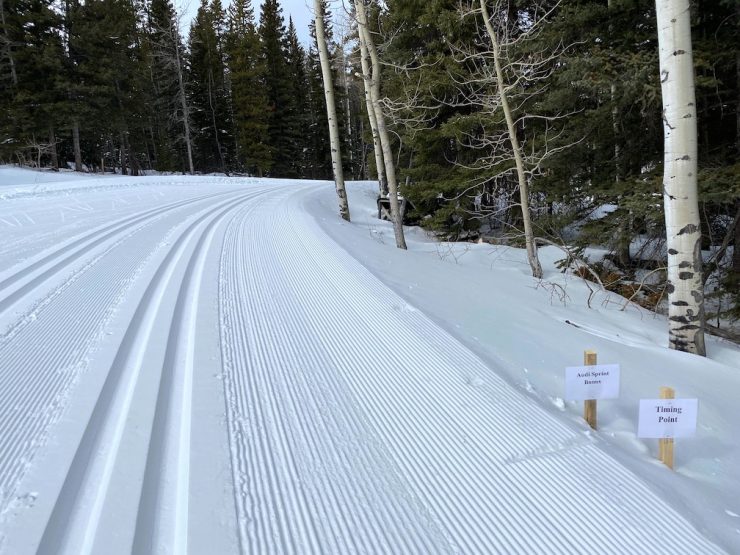
After skiing a few laps of the Canmore race course, it was not possible to escape that superhero feeling. With real snow, the descents are much less thrilling and the heart rate actually drops. Climbs become a matter of floating a good tempo while watching sunlit mountains, not just eyes down chasing clean snow.
After so many visits, it suddenly became clear why people choose to live in Canmore. Skiing up a climb and remembering Beckie Scott blowing up the group on that exact spot way back in 2005, I felt the road trip was worthwhile just to see Canmore at its best.
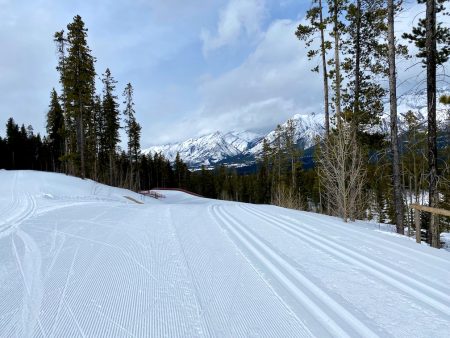
After the ski, new realities began to set in and it became clear we would have to skip the Minnesota leg of the trip. Missing the first US World Cup since 2001, missing Jessie Diggins finally racing at home, missing the Europeans experiencing the hotbed of US skiing, missing a chance to ski in a place I have never visited.
It was a blow, but you can’t ignore expert advice. Visiting Minnesota would almost certainly come with a 14 day quarantine that was not compatible with the primary season goal of racing the 50km at Nationals on my home trail system.
This decision was shortly followed by the announcement that Norway had done the wise thing and stopped their team from travelling to Canada. Anyone who was exposed to Coronavirus in Oslo during Holmenkollen would start to show symptoms in Québec.
Road Trip Day 2 (Wednesday)
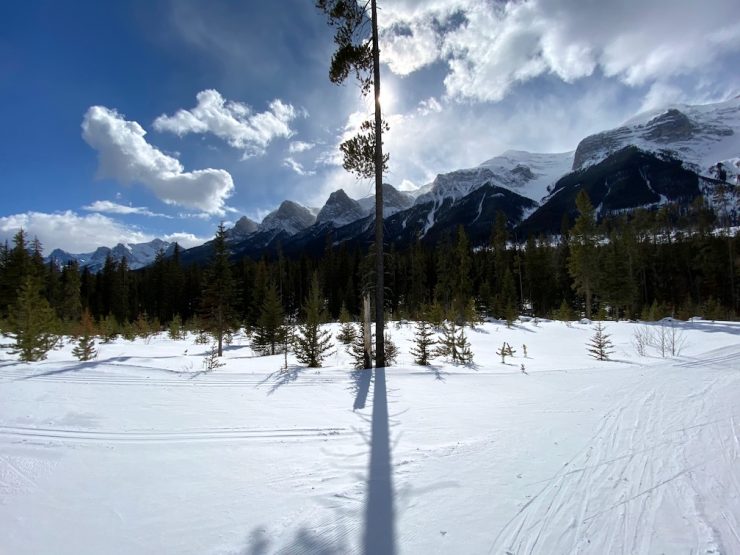
Day two of the road trip was a bonus day at Canmore as our original schedule had us driving in the morning. The ski plan was for zone 4 intensity while staying out of sight of the elite distance skiers (Canadian and otherwise) training here. This was a calming session before what was going to be a difficult afternoon interview with the Canmore event chair, Norbert Meier.
The news got better while I was offline skiing those amazing rec trails (Bow and Rundle!), with a pandemic officially declared and approval to continue with the all three World Cup events confirmed. The result was a shorter and easier interview with Meier, followed by confirmation that the Italian team was taken out by Italy’s lockdown despite arriving in Québec.
Two nations down (Norway and Italy), one destination removed –but the trip goes on.
Québec City LOC confirmed athletes were skiing in sunshine, the spectators would be safe, and that a new mixed zone design would keep both athletes and media safe. Sovereign Lake confirmed that Nationals was approved to proceed. Canmore was predicting great weather and the sun was out. All good news until the USA closed their borders against Europe. The Minnesota World Cup was cancelled shortly after.
Road Trip Day 3 (Thursday)
Day three started with an early dash to the airport and a chance to think about the cancellation of the Minnesota WC. As we listened to the ‘switch devices to airplane mode’ announcement, an email arrived with subject line ‘Nordiq Canada Cancels’. Our skis were loaded, the doors were locked, and we were about to take off. Definitely too late to hear news from Québec.
A stolen 30 seconds of internet later, the full message was worse: Nationals and SuperTour finals were cancelled.
My home club worked hard to win the bid for Nationals and put together the event: Partnering with SuperTour, finding sponsors, preparing trails, upgrading one of the BR 400 snowcats, setting the race loops full FIS-width through six weeks of almost daily snowfalls.
I personally committed to racing the 50km in August, resulting in a new training plan and a lot of time spent preparing to race a very different style of course than masters are accustomed to. None of that matters. Decision made. Dreams broken. Partnerships strained. When we finally return, it will be to a club staring down a large financial problem and angry friends. Cancellation insurance does not usually pay out on global events or government decisions, but there were photos of the waxing tents set up on Wednesday and that money is spent.
Success is easy. It is easy to divide up profits in a joint event. All the partners stay friendly even if they argue about who gets how much money. Dividing up losses on a cancelled event is ugly. Volunteers lose heart when their hard work evaporates. Sponsors think twice about future events. Money already spent is simply lost.
This is a common occurrence in winter sports and it is my club’s turn to feel the pain. Will it hurt less in Minnesota? Nope. Will I know less people who are hurt in Minnesota? Yes, but all those volunteers, sponsors, and organizers feel just as bad as my friends at Sovereign do. And myself: I only spent about 20 hours on the bid process and would have spent a few more hours collecting social media content for final promotion. Despite this tiny investment, I feel the pain. Most of my social circle invested far more time than I did and their pain will reflect that.
For me, there is more pain to come. I will find a silver lining to all those training hours. The thrill of being the only racer with a three digit license number will somehow balance the fact that the club can’t afford to refund registrations and Nordiq Canada will not refund that license I will now never use. The total pain of racing a 10km to earn essential CPL points will be re-interpreted as a character building experience.
Next year, there were going to some fun new events at the club. Can they happen as the club rebuilds financially? Probably not, but we won’t know until after closing day on April 12th when the accountants will have the full picture.
Next year’s national team selections rely heavily on results at Nationals. Period 1 selections likewise. Nordiq Canada will have to pivot away from the rebuilding plans to deal with short term challenges.
So many athletes mentioned to me that one specific event at Nationals was one of their season goals. Sorry, goodbye to all that.
Sport is often about dealing with disappointment. Ingvild Flugstad Østberg followed up the joy of finally winning the World Cup overall with missing the start and end of this season for health reasons. Klæbo acted his age and broke fingers gifting Bolshunov the overall title in what would have been a spectacular battle, following up last year’s battle that fizzled out with one day to go when Bolshunov broke a pole.
What we admire about athletes is their ability to bounce back, to find a way to fight again. Not all succeed, which is why we celebrate those who do. Away from the perfection of Instagram and the TV cameras, the pain, the uncertainty, the self-unconfidence all play out before the tough ones find their way back to the hard work which is both path and reward.
For the people who host events, there are only bright lights and TV cameras when everything has turned to custard. Their wins are not noticed, their failures are celebrated. Where do these people find the courage to bounce back and try again?
Beyond these worries, day three continues to be exciting. On landing in Toronto, we read an announcement that people arriving in Québec should self-quarantine for 14 days and that indoor events with more than 250 people must be cancelled, shortly followed by the suspension of the NHL season.
To fly on or turn back? Canmore announced their own cancellation during this brief stop. Meier sent an apology, as he got the first warning that precipitated this decision only a few minutes after our interview Wednesday.
A call to Jeff Ellis, Nordiq Canada’s Event Director, confirmed that Québec City (QC) was proceeding as an outdoor event. Simple answer, get on the (delayed) connection to QC with Jessie Diggins (who had been keeping her social distance in the waiting area like the total professional she is) and hope for the best. At the QC airport, NC’s Dave Dyer was there to pick up his colleagues from the flight. He laughed when he saw we had a ski bag. Does he know something we don’t? Always.
QC is a great place to visit and a better place to eat. We had a good dinner next to the French Ski Team’s wax techs and ignored their speculation about meetings while reading about BC’s new 14 day self-quarantine rules. One of the nice things about four World Cup events in a five year period is that we have favourite places to eat and drink here.
Day Four (Friday)

We woke to freezing rain and a press release stating Canada’s ski team was dropping out – a stance taken in solidarity with Norway, Germany, Sweden, Finland, Great Britain, the Czech Republic, and the United States. The rain turned to snow before the LOC, Gestev, sent their own press release at 8am cancelling the event.
Many athletes were braving the wind and driving snow to get in a morning ski while FasterSkier waited for an interview with FIS Cross Country Race Director Pierre Mignerey. Ellis filled in some time explaining the details of the cancellation.
At the event hotel, there was time to catch up on the news and grab a few interviews. Here’s what I learned: Canada decided at the team meeting at 8pm Thursday that pulling out of the event was the only option. As much as NC, FIS, and the LOC have contracts requiring them to make every effort to go ahead, the team has to protect the athletes. FIS was notified after that meeting. NC sent out the press release at 1am, and FIS formally cancelled at 8am.
Ellis also explained the personal side for the Canadian athletes, who paid for their own flights and accommodation.
“Our athletes here, we feel bad for them. I have one world cup start, as a nations group starter. Was I a competitive world cup skier? No, I was third last, but I can say I did a world cup. I empathize with our athletes, that this was their chance to get one. At the same time, we have to keep them here, knowing that they’re going to have to back through international airports. We can say they are safe in the bubble here, but we have to think about what we are sending them home to. The longer we keep them here, we are putting them at risk if we start to see shutdowns in the country. At the end of the day, that’s more important.”
An ugly scenario, but at each point people made the only decision they could. While governments had been signalling that travel and assembly guidelines would change, it is not possible to cancel a multi-million dollar event based on speculation.
“What changed in 8 hours yesterday, from BC, to Ontario schools closing for two weeks, to curling, to figure skating, we don’t want to be the last one standing in this regard, it’s not an enviable position to be in,” Ellis said about BC’s 14 day self-isolation rules, the World Curling Championship in two BC cities, and World Figure Skating Championships in Montreal.
In large events like these, there is a complicated dance around the contracts between partners. The only accepted reason for the LOC to cancel is the legal concept of ‘force majeure’, which is something beyond the control of the LOC. This could be a lack of snow causing a jury decision, a safety issue, or a government decree. At Holmenkollen, it was the City of Oslo that ordered the event closed to spectators. in Québec, the withdrawal of six teams precipitated the declaration.
It seems likely that event contracts for sports and conferences will be worded differently in the future.
As Mignerey said, it is a small family driving around and skiing in different places. At the sudden end of a long season, there were a lot of hugs and a lot of people carefully not shaking hands. Standing on the edge of this crowd feels like being a plus-one at a family reunion: Everyone is friendly and welcoming, but there is a closeness and history that the guest is not part of.
The silver lining, because we always need some light on dark days, is that I shot video from a World Cup venue. If Jessie Diggins can dredge up some positive to have a friendly conversation shortly after having her dreams crushed, I can enjoy this twisting road trip that didn’t quite live up to the brochure.
How to sum up?
Athletes had their dreams crushed. Some will never get their first World Cup start.
Organizing Committees worked hard and were inadvertently rewarded with deficits and disappointment. Fans lost the chance to see some great racing on fabulous snow.
In the bigger world around us, the picture is different. People are watching family members die. Workers are ordered to self-quarantine without pay. Hospitals are being overloaded and doctors are having to choose which patient gets the life-saving equipment.
So yes, the cancellations personally hurt, they hurt many of my friends more, but I will find my way back to the positive. Soon.
Day Five, Saturday
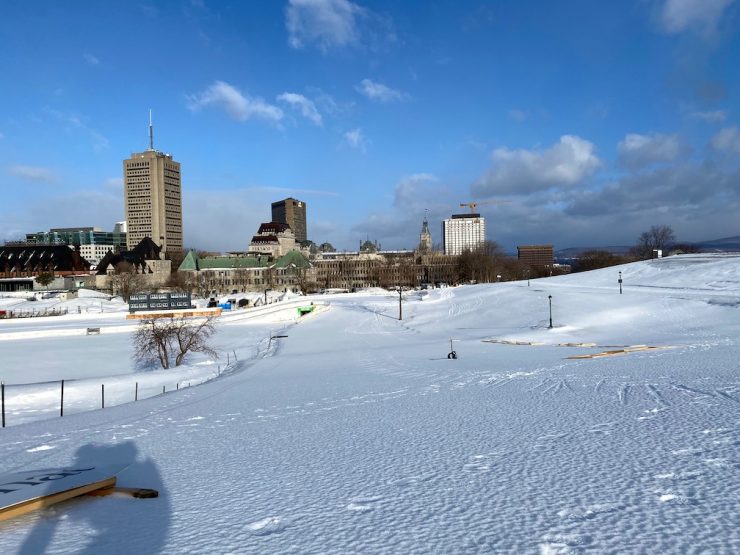
After a great tortière and some Griffon Rousse beer last night at one of our favourite restaurants, the world was in a positive light again. Symbolically, the sun came and went during a morning ski on the race course. By 11am, most of the athletes, fans, and teams had left, which means the internet is suddenly faster at the hotel. Many of the countries that had discussed closing borders followed WHO guidelines and left them open with self-quarantine requirements. We were able to reschedule our flight to Saturday afternoon for a tiny fee (thanks WestJet) and will soon be in driving distance of home.
Federico Pellegrino posted his road trip story on Instagram, revealing that he didn’t want to leave Italy when it was already clear that the COVID-19 situation was going to get worse everywhere. As a skier who saw his home ski area closed on March 7th as part of Italy’s lockdown and a resident on the edge of the most affected part of Italy, he knew that the English-language media was understating how bad the problem was.
They are calling my flight.



